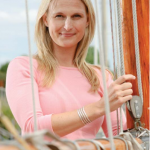March 2016
Monthly Archive
Monthly Archive

Dr. Kimberly Monk, of the University of Bristol, reached out to us after seeing a posting on a maritime archaeology group on LinkedIn. Dr. Monk, originally of Canada and now residing in the U.K., has done a lot of research on the Battle of Hudson Bay. She has a special fondness for “Soggy Dames”, also known as sunken ships, and has done several maritime archaeology projects. Her most recent focus in researching timbers used in ships.
Nothing fascinates Kimberly Monk more than a pile of soggy wood. It may not seem like a promising subject of study, but it has formed the basis of her career in the Department of Archaeology and Anthropology, where she is co-ordinator of the MA in Maritime Archaeology and History and lecturer for postgraduate and undergraduate units on maritime archaeology. The search for said dank and dripping data – shipwrecks, in other words – takes her to locations as diverse as the British Virgin Islands, the North American Great Lakes and the balmy waters off the south-western tip of the Cornish peninsula.
But don’t be fooled – reaching the shipwreck sites themselves often involves working in hazardous conditions. Monk is a veteran of the underwater world; a former professional diver, she admits to having swum against the prevailing current. ‘You usually start out as an archaeologist, develop your specialism and then learn how to dive to search out your investigation sites,’ she says. ‘I did things the other way round.’
Monk was born and raised in Toronto. Having shelved her original plans to pursue a degree in veterinary medicine, she was working as a scubadiving instructor when she came across some maritime archaeologists monitoring shipwrecks in the Fathom Five National Marine Park in Tobermory, Ontario. ‘I was fascinated by what they were doing – it was like underwater detective work,’ she says. ‘I was also interested in the conservation aspects of their work. As a diver, you’re very aware of the need to protect fragile environments.’
For all the interest generated by early adventurers such as Jacques Cousteau, and despite pioneering work in the 1960s by George Fletcher Bass, founder of the Institute of Nautical Archaeology, maritime archaeology was still an underdeveloped academic field as recently as the 1990s when Monk looked again at her academic options. ‘It took a while for maritime archaeology to shake off its early associations with treasure hunting,’ she says. She embarked on an archaeology degree at the University of Western Ontario and got her underwater fix by volunteering in her spare time for Save Ontario Shipwrecks, an organisation dedicated to the study and preservation of Ontario’s marine heritage. Thus began a love affair with the North American Great Lakes. ‘They’re ideal for exploration,’ says Monk. ‘They contain masses of wrecks because historically shipping was the predominant means of transport, even up until the early 20th century. Everything, from people and animals to food and building materials, was transported in wooden bulk carriers.’
After completing an MA in nautical archaeology at East Carolina University, Monk chose to pursue a PhD at Bristol, a move that put her ‘in the right place at the right time’ when the opportunity arose to co-ordinate the Maritime Archaeology Master’s programme.
It’s the human stories behind the findings that most interest Monk, especially when the humans have names like Pierre Le Moyne D’Iberville. Another British warship, HMS Hampshire, is Monk’s latest interest is the 1697 Battle of Hudson Bay. It’s the only naval battle to have taken place in Arctic waters. The Battle of Hudson’s Bay took place when a French warship defeated an English squadron to take York Factory, one of the Hudson’s Bay Company’s trading posts. ‘It wasn’t the most glorious epitaph for the English fleet, losing a 50-gun ship and a Hudson’s Bay Company ship along with the fort,’ says Monk. ‘But the loss of the French ship the following day would have been a consolation.’ We look forward to helping Dr. Monk learn more about the Battle of Hudson Bay up close.
(excerpt from University of Bristol, “Subtext”, 2009)
0 comments Tuesday 29 Mar 2016 | David | Expedition Diary
We are pleased to announce Dr. David C. Smith and Dr. Chris Milligan, both of McGill University, have joined as Advisers to Fara Heim. They are experts in the history of the Battle of Hudson Bay. They wrote a very in-depth book on Le Pelican for the Stewart Foundation and recently released a very historical fiction book called “Check Mate!”.
Get their books here:
0 comments Sunday 20 Mar 2016 | David | Expedition Diary
|